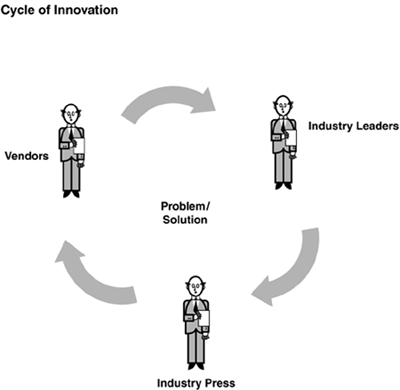Market Dynamics
When companies within an industry encounter similar problems they engage in a search for answers, sometimes collectively and sometimes individually. As an idea for a solution emerges, resources begin to group around it. Industry leaders recognize it as a good solution and they begin to talk about it, the industry press picks it up as a story, and vendors begin to target the market that emerges. Figure 18.1 shows the cycle of innovation that ensues.
Figure 18.1. Innovation within an industry occurs around three key resources.

Any of the three key resources (industry leaders, industry press, and vendors) can initiate the cycle and can contribute to the solutions identified. Innovation is an ongoing process that peaks at times of greatest need and when the industry achieves new discoveries that are then incorporated into all the surviving participants. For instance, the cable TV and telecommunications industries are now racing to incorporate advanced technology to provide increased consumer bandwidth and the services it promises, such as video-on-demand and interactive applications for the retail consumer.
The CRM Market
The CRM marketplace has grown out of the synergy of several markets over the years. Direct mail, customer database services (Marketing Consumer Information File or MCIF), contact management, and sales force automation are some of the precursors of today's CRM software market. Meanwhile, the industry at large has seen the convergence of the Internet as a business channel, the development of business intelligence tools in the data warehousing market space, and the business practice of reengineering. CRM is at the apex of these converging technologies, along with the related arenas of ERP and SCM.
For example, in banking, customer information is often delivered through the MCIF or marketing customer information file. Banks produce extracts from their customer master files, and any other files that contained related data on accounts, such as transaction and financial information files, and ship these files to the MCIF provider. The data then undergoes scrubbing and cleansing routines to homogenize the information and is enhanced with selected external information, such as the NCOA (National change of address) database, and geo-coding or demographic data.
With the prevalence of merger and acquisition activity in banking, one bank sends out more than 100 extract files to be cleaned up and merged into a comprehensive customer information database. The data is delivered via tapes or transmissions, and then loaded into a vendor-provided system providing a front-end with reporting and analytical capabilities.
CRM Competitors
Most CRM competitors field solutions for verticals—applications designed for companies in a specific segment of a market. For example, Siebel targets the financial services industry with its sales force automation program. Microsoft CRM however, will be sold across vertical channels.
Industry experts predict that Microsoft CRM will change the face of the CRM industry in the following ways:
Enlarging the market in the small business space
Forcing CRM mid-market players to adopt a focus on vertical niches or to stay with national markets to remain viable
Becoming an everyday, commodity desktop feature such as email, spreadsheets, word processing, and PowerPoint
Microsoft's competitors providing CRM software include the following:
Saleslogix (http://www.saleslogix.com/home/default.php3)— The CRM division of Best Software has roots that go back more than 15 years. One of five U.S. divisions under Best Software, the CRM Division is comprised of two award-winning product lines, ACT! and SalesLogix. Both products are focused on the sales business process.
Frontrange (http://www.frontrange.com/)— The new FrontRange offering, which combines core CRM functionality plus unique features for vertical markets, is developed specifically for midsize companies. The contact-management function for each module, for example, is modified according to industry preference, such as projects and quotes for manufacturers and clients and portfolios for financial services.
Oncontact Software (http://www.oncontact.com/index.asp)— Oncontact develops customer-relationship management (CRM) systems for mid-market companies.
Salesforce.com (http://salesforce.com/us/)— With strong support for tracking contacts, leads, and customer inquiries, salesforce.com ($50 per user per month) offers functional online customer management and meets the needs of small businesses, with a capable set of features at an attractive price.
Epicor (http://www.epicor.com/solutions/crm.asp)— Offers award-winning customer relationship management (CRM) solutions that enable you to have full visibility of your customer relationship so that you can provide improved levels of service to your most important asset.
UpShot (http://www.upshot.com/index.html)— Sales-focused CRM, UpShot provides Web-based CRM focused entirely on increasing sales. This solution promotes closer coordination of sales and marketing activities, helping sales organizations close deals faster and more predictably, and helping marketing organizations produce a better return on their investments, resulting in more and better leads.
Applix (http://www.applix.com/index.asp)— Applix iCRM is a suite of collaborative CRM and analytics solutions that optimizes Web-based marketing, sales, customer service, partner management, quality assurance, and help desks. Enterprises improve their customer acquisition, satisfaction, and loyalty with this highly adaptable, integrated suite of CRM solutions.
Firepond (http://www.brightware.com/)— Firepond offers products and services that are tailored to the specific requirements of companies in select industries, including manufacturing, insurance, financial services, telecommunications, transportation, and high technology.
Pivotal (http://www.pivotal.com/pivotal.asp)— Pivotal provides software, services, and support required to produce significant improvements in marketing, sales, and service effectiveness for mid-level enterprises. Specializes in easily customizable software for flexible implementations.
Siebel (http://www.siebel.com)— Siebel's product line for CRM marketing targets large enterprises, but also comes in a midmarket version. Pricing starts at $1,350 per named user, with additional modules starting at $100 per named user. The product suite includes Siebel Marketing, Siebel eMarketing, Siebel eEvents, and Siebel Marketing Analytics. Siebel also offers vertical industry applications in the areas of finance, insurance/healthcare, communications, energy, consumer sector, life sciences, public sector, automotive, travel, and transportation.
Onyx (http://www.onyx.com)— Onyx Enterprise CRM version 4.0 provides a Web-based CRM solution built on a leading-edge Microsoft technology-focused platform. Onyx is one of the leading vendors for the small and midsize business market.
